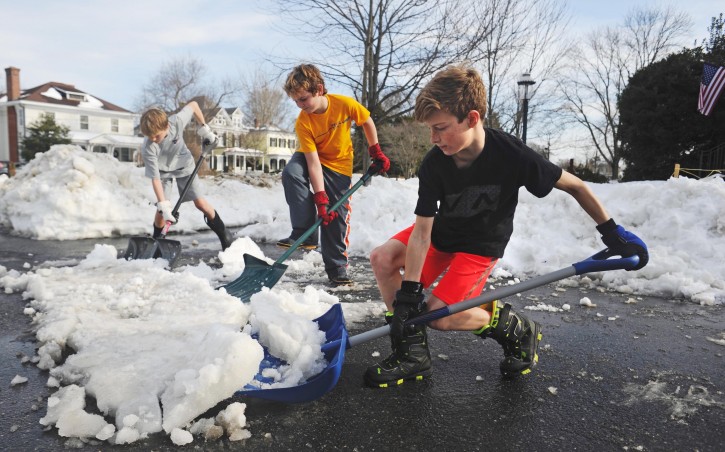 Hagerstown, MD – Last weekend’s crippling blizzard was the fourth most powerful snowstorm to hit the Northeast in at least 60 years, the National Oceanic and Atmospheric Administration announced Thursday.
Hagerstown, MD – Last weekend’s crippling blizzard was the fourth most powerful snowstorm to hit the Northeast in at least 60 years, the National Oceanic and Atmospheric Administration announced Thursday.
Subscribe to our Daily Roundup Email
The agency gave the storm a rating of 7.66 on the Northeast Snowfall Impact Scale, which ranks storms according to inches of snowfall, geographic reach and population affected. That bumps down to No. 5 the Presidents Day weekend storm of 2003, which had a score of 7.50.
The blizzard last Friday through Sunday affected 102.8 million people and covered about 434,000 square miles in 26 states, NOAA spokeswoman Maureen O’Leary said.
Almost 24 million people saw more than 20 inches of snow and 1.5 million got more than 30 inches, according to National Weather Service meteorologist Paul Kocin, who helped develop the scale. He called the storm a slightly smaller version of a January 1996 blizzard, No. 2 on the list, which covered a similar area.
“This storm ranks up there with the great blizzards of the past 100 years in terms of amount of snowfall, size of impacted areas and population affected,” Kocin said in a statement.
The scale doesn’t take into account other misery metrics, such as storm-related deaths, flight cancellations and power outages.
“We try to keep the scale as simple as possible,” Kocin explained in a telephone interview.
The storm dropped snow from Louisiana to Maine and across parts of the southern Midwest. It also caused damaging coastal flooding in New Jersey.
At least 52 people in 11 states and the District of Columbia died in storm-related incidents including car accidents, carbon monoxide poisoning and heart attacks while shoveling snow.
One of the highest snowfall readings was 42 inches, in Glengary, West Virginia, where some counties remained under states of emergency Thursday.
This storm was unique for its high level of predictability, Kocin said. Forecasters saw it coming a week in advance and accurately predicted snowfall amounts for most places days ahead of time. Notable exceptions included northern New Jersey and New York City, where snowfall was heavier than initially forecast, he said.
The most powerful storm on the list is still the so-called Storm of the Century, which dropped more than 30 inches of snow in spots along a swath from Mississippi to Maine in March 1993. That ferocious late-winter blast, characterized by NOAA as a superstorm, scored 13.2 on the scale. It affected more than 100 million people and caused more than $2 billion in property damage in 22 states, according to NOAA’s website.
This weekend’s storm’s economic impact is still being calculated. Earlier this week, economists at Moody’s Analytics pegged the lost economic output to $2.5 billion to $3 billion. That estimate just represents lost income for hourly workers and skipped consumer spending. It doesn’t include damage to roads or other infrastructure.
In Maryland alone, where officials are seeking federal disaster aid, emergency management officials say they expect tens of millions of dollars in snow removal costs, damage to public property, and emergency measures to protect lives and property.
Baltimore Mayor Stephanie Rawlings-Blake hasn’t put a dollar figure on the recovery efforts, but said “anytime you have a historic storm, the budget will be historic as well.”
In Virginia, Gov. Terry McAuliffe said the storm may turn out to be the state’s costliest, wiping out a $200 million snow response budget.
Federal workers in the Washington area have yet to have a normal day since the snowstorm. The government was closed from noon Friday through Tuesday. On Wednesday and Thursday, federal workers started with a three-hour delay
Some students in Maryland and Virginia learned that their snow holiday will continue through Friday. Crews in Baltimore and Washington were still working to clear streets, and trash collection remained spotty in places.
Virginia had the highest death toll — 12 — and state police there reported more than 8,400 calls for assistance.
At least five deaths across the region involved people sheltering inside cars that filled with carbon monoxide after their exhaust pipes were covered by snow. They included a 3-year-old girl in Passaic, New Jersey, who succumbed Wednesday, four days after her mother and brother died as her father shoveled snow outside their running car.
A state of emergency continues through Friday afternoon in four West Virginia counties. The state transportation department says it used about 22,000 tons of road salt in four days.
More than 127,000 people lost power during the storm in Georgia, Tennessee and Alabama. Northern Alabama saw several inches of snow.
